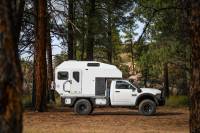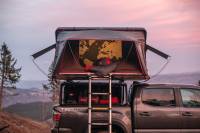The Best Options for a Good Night’s Sleep While Overland Camping
Overland camping offers a lot of options to choose from when adventuring off the beaten path.
And let’s be honest. Overlanding is, for most folks, another word for car camping. So if you’re getting into the world of driving down dirt roads and sleeping under the stars, we’ve got your back.
Picking the best sleeping quarters when overlanding depends on several factors, including things like finding the perfect parking spot for your vehicle and searching out enough flat ground to set up a tent for midnight Zs.
Luckily, with a little shopping around, adventurers can find the perfect overland camping gear for their on-the-go lifestyles.
Back to Basics: Ground Tents for Overland Camping
Everyone starts from somewhere. And camping while overlanding is no exception, whether you’re borrowing someone else’s tent for your first-ever outing or you are a seasoned ground tent camper with multiple tents for every occasion.
And if you’re shopping for a new tent, you can find a wide variety of tents that offer varying degrees of sleeping comfort and packability.

Bivy Sacks
A premium-made bivy sack, short for a bivouac sack, is a weatherproof or nonwaterproof breathable cover for your sleeping bag — a bare-bones shelter, if you will. This product was invented to serve climbers who needed emergency protection when sleeping against rockfaces. In essence, it’s a protective outer layer creating a sleep-inducing cocoon to protect your sleeping bag against the elements.
Some bivies zip shut entirely to keep water and little critters out, whereas others include a small pole to keep the material off your face as you dream of future adventures. A lightweight, low-volume option, bivies won’t take up much space in the back of your adventure rig. However, this basic shelter might not be an ideal solution for vehicle-assisted travel where space constraints aren’t as much of an issue.
Backpacking Tents
Campers searching for a bit more room may opt for lightweight, single, or two-person backpacker ground tents. Made from heavy-duty materials with key niceties, these tents can give your back a break and offer protection in extreme weather.
Many of these tents, like those from MSR, The North Face, or Mountain Hardwear, are made from thin but durable material, have taped seams, a dedicated rainfly, and more features.
Similar to bivies, these lightweight tents pack up into a small package and will take up little room in your vehicle. However, tiny tents don’t allow for certain creature comforts. Diminutive tents house little gear and can be claustrophobic, offering only a small space inside for essentials.
Backpacking tents are small for a reason; however, they are more of a shelter than a place to call home.
Car Camping Tents

In the event that you want more space while tent camping, larger 4-season tents, like those from Shiftpod, are made in all shapes and sizes. Ideal for taking family trips, stowing gear, and making life around camp a whole lot easier, some of these tents have unique features, like separate vestibules for stowing gear or changing clothes.
Four-season tents will be larger and heavier than either a bivy or a backpacking tent. But given your adventure rig will be hauling the weight around, this is one case where splurging on a larger tent might make sense.
Keep in mind that you will need a flat place to pitch your tent. So the larger the tent’s footprint, the more time you might spend looking for an accommodating backcountry spot to set up your campsite.
Tip: Do your research before purchasing a bivy sack or ground tent to understand its size, features, and other accouterments.
Treehouse Fun: Rooftop Tents for Overland Camping
If you don’t want to snooze on the ground and would rather sleep atop a vehicle or off-road trailer, a rooftop tent may be your ticket to enjoy overnight camping.
The rooftop tent has gained recent popularity among overlanders and outdoor explorers alike. First made in Italy in 1958, the rooftop tent now comes in a wide variety of shapes, sizes, and configurations.
This style of tent offers a unique camp solution by mimicking a treehouse experience, complete with ladders and a sense of wanderlust. Sleeping up off the ground means campers won’t have to worry about hot, wet, or cold ground conditions or scurrying critters — hopefully resulting in a better chance for restful nights.

Types of Rooftop Tents
Rooftop tents vary in design. Offerings include soft-shell, foldout rooftop tents with zippered, rubberized covers. Or it could be a hard-shell tent that unclasps and can be raised into place via struts. Many iterations exist.
Sizes and configurations also vary. Some tents can accommodate one sleeper with a simple, single-ladder design. The deluxe units can fit up to a family of four and often incorporate features like two ladders and an enclosed annex room beneath the tent for additional campsite living space.
Companies like CVT, Alu-Cab, and James Baroud offer premium rooftop tents and have many features that make rooftop living worth it. Waterproof materials and stout manufacturing keep nature’s elements out while zippered windows with clear and mesh openings allow ventilation and the chance to peek at your surroundings.

Three- to 4-inch high-density foam mattresses cushion sleepers of all sizes. The zippered covers can easily be washed. Campers also get ample storage with cubbies for headlamps, sunglasses, or hiking boots.
Higher-end models boast integrated LED lighting. And select hard-shell models can even come equipped with internal fans to help ease condensation issues.
Rooftop Tent Pros & Cons When Overland Camping
Rooftop tents are generally more expensive than ground tents. They also weigh more and need to be permanently mounted to a vehicle or adventure trailer. Like ground tents and bivy sacks, rooftop tents must be aired out and fully dried after each use; otherwise, mold and mildew can set in and is extremely difficult to remove.
Rooftop tents, once mounted on a vehicle’s roof, change the vehicle’s driving dynamics, creating a higher center of gravity — something to take note of if you frequently tackle tough trails. Additionally, the added height will make it difficult to drive through low areas.
Whereas bivy sacks and ground tents can easily tuck up against shrubs and trees for a windbreak, rooftop tents atop a trailer or adventure rig aren’t as easy to keep away from wind or challenging weather.

Note: Make sure your vehicle or roof rack system can hold the extra weight of a rooftop tent as well as its occupants and gear. Understand your vehicle’s dynamic capacity (its moving load limit) and static weight allowances — do not exceed them.
Sleeping Inside Your Car, Truck, or SUV
If you’re looking for a one-stop adventure shop where you drive and sleep within one area, setting up camp in your van, truck, or SUV may provide you overlanding success.

Sleeping in your vehicle can offer you warmth, comfort, silence, and stability. You can build a temporary sleeping platform coupled with an inflatable sleeping pad and double-wide sleeping bag like in our Mitsubishi Delica van. Or you could build out a robust, permanent system in the back of a Tacoma.
Gone are flapping tent sides, wet sleeping situations, and potentially sore backs. Campervans and other in-vehicle sleeping setups can offer the utmost luxury.
Plus, you have everything at your fingertips, including your fridge or cooler for midnight snacks.
Customized In-Vehicle Options, From DIY to Manufactured
In-vehicle sleeping setups can be custom-made, like those from van outfitters like Benchmark, Outside Van, or Zen Vanz. However, you can construct a simple setup at home with strategic planning and some elbow grease. Check out the many online tutorials online for homemade setups should you choose that path.
You can consider many materials in your build, like wood, metal, or durable plastic. But keep in mind how much weight you’re adding when changing your vehicle from a stock runabout to an adventurous overlander.

In addition to customized sleeping setups, off-the-shelf products are also available to turn your daily driver into a sleeper vehicle. DECKED makes several truck bed systems that include a full-length drawer system and sturdy platform top, perfect for a sleeping pad, sleeping bags, and a good night’s sleep.
Other companies, like Super Pacific or Go Fast Campers, offer a hybrid pop-top truck bed sleeping setup. Simply pop the top (like a rooftop tent) and enjoy a lofted sleep experience while your truck bed stores other cargo. Still others, like Napier, offer tent-like setups that affix to the rear of a truck bed or SUV for a hybrid experience.
Take Note of Design, Expense, and Especially Payload
However, in-vehicle setups can have drawbacks. Campervan systems that include a sleeping platform behind the first row of seats forfeit the ability to carry passengers. Also, you may need to move your sleeping quarters to reach any cargo stashed below. The extra weight can negatively affect fuel economy and vehicle performance as well.
Additionally, off-the-shelf or customized sleeping quarters can be very expensive, depending on features and build quality. It’s important to analyze how you plan to sleep when overlanding to find the best sleeping quarters to accommodate your traveling style.
The final and most important issue is to understand the payload of your vehicle. Packing your car to capacity also means you’re testing its weight capacity. And payload is exactly that: it’s the weight that your car can pack inside of it (or in the bed) without causing potential harm to the vehicle or creating a safety issue.
This is separate from your vehicle’s towing capacity. And you can typically find it online. Or you can calculate it yourself by subtracting your truck’s curb weight from the gross vehicle weight rating (GVWR).
The takeaway here? Learn your payload. Do not max it out.
Overland Camping Your Way: Choose the Best Sleeping Quarters for You
No matter how you plan to overland, taking into consideration key factors like weight, space, cost, efficiency, and comfort level will help dictate your choice.
If you’re a light packer and don’t carry a lot of gear, a backpacker tent or bivy sack should suit you well. If you’re more of a car camper who overlands with buddies or family, carrying a larger tent or using a rooftop tent will set the stage for sleep.
And, if you’re self-sufficient in your vehicle and want to sleep in it, a customized sleeping platform or truck bed camp setup will send you on your way to comfortable overnights.
Do your research. Set your budget. And understand how (and where) you want to sleep. With a little bit of planning, you’ll soon be enjoying all the overlanding outdoor adventures — after a good night’s rest.
The post The Best Options for a Good Night’s Sleep While Overland Camping appeared first on GearJunkie.


